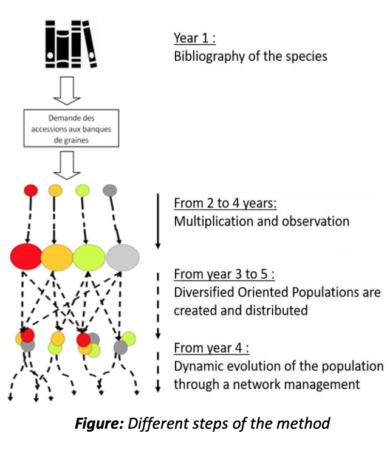- Small farms are not just beautiful. Yes, the original paper was in Brainfood back in March, but this website seems to be new.
- DivSeek has a new strategic plan to “improve the generation and sharing of information about global plant genetic resources”: accelerate, add value, educate. Small farms unavailable for comment.
- Speaking of sharing information on global PGR, we need to do that for wheat genes, wheat gene scientists say.
- Probably for tannins too, come to think of it.
- FAO says climate change will make pests and diseases worse.
- FAO also says that livestock are not as bad as many people think.
- The sincerest for of flattery on display in South Korea.
Liveseed mixing it up with genebanks
We’ve Nibbled Liveseed before, but I think it’s time for a little bit more. It’s an EU-funded Horizon 2020 project with the objective “…to improve transparency and competitiveness of the organic seed and breeding sector and encourage greater use of organic seed.”

Though the main focus is breeding, there is also some work on cultivar mixtures, which is actually what prompted this post. Because a nice poster by Emma Flipon (ITAB) and Véronique Chable (INRAE) has just been made available on “How to create diversified variety mixtures based on gene bank resources.”

Always great to see different ways of using genebanks, including ones that don’t necessarily include breeding.
Brainfood: Sorghum rescue, Barley mixtures, Agroecology, Tepary genome, DSI x 2, Cryo guac, Seed regulation, Recipe design, White clover diversity, IK wheat, High maize
- The recent evolutionary rescue of a staple crop depended on over half a century of global germplasm exchange. Sorghum in Haiti was saved from pest by breeders mixing up material from all over the place.
- Does crop genetic diversity support positive biodiversity effects under experimental drought? Not straightforwardly, at least for barley cultivar mixtures in pots.
- A Nutrition-Sensitive Agroecology Intervention in Rural Tanzania Increases Children’s Dietary Diversity and Household Food Security But Does Not Change Child Anthropometry: Results from a Cluster-Randomized Trial. Well at least it’s more straightforward than the above.
- The tepary bean genome provides insight into evolution and domestication under heat stress. Better heat adaptation than common bean, but less disease and pest resistance.
- The international political process around Digital Sequence Information under the Convention on Biological Diversity and the 2018–2020 intersessional period. Can’t take the above for granted.
- Practical consequences of digital sequence information (DSI) definitions and access and benefit‐sharing scenarios from a plant genebank’s perspective. Genebanks trying not to take the above for granted.
- Cryopreservation of Woody Crops: The Avocado Case. There’s been a breakthrough in shoot tip cryopreservation.
- Using Regulatory Flexibility to Address Market Informality in Seed Systems: A Global Study. Regulatory flexibility would certainly be a breakthrough for linking formal and informal seed systems. And, incidentally, not bad for DSI either.
- A recipe development process model designed to support a crop’s sensory qualities. When you want to make a recipe for a new ingredient (crop or heirloom variety), start with what makes the ingredient special, not with what might make the end-product special.
- Genetic diversity and population structure analysis in a large collection of white clover (Trifolium repens L.) germplasm worldwide. Native and introduced populations are genetically differentiated.
- Limited haplotype diversity underlies polygenic trait architecture across 70 years of wheat breeding. Crunch time for UK wheat breeders: continue shuffling within the existing diversity, or expand it?
- Molecular Parallelism Underlies Convergent Highland Adaptation of Maize Landraces. Adaptation to high altitude from the SW US to the Andes was due to wild genes from the Mexican highlands.
Nibbles: Food/feed, Saving collards, Intoxicant history, Watermelon origins
- Livestock not so bad after all.
- Especially with collards.
- I’ll drink (or take another intoxicant) to that.
- Maybe cleanse the palate with a nice fresh watermelon.
Brainfood: Hemp microprop, Old dates, Central Asian double, Herding, Desert kite, Regeneration, Editing, Wild potato, Tomato landraces, Edible mycorrhizal fungi
- An In Vitro–Ex Vitro Micropropagation System for Hemp. Hope it doesn’t drive down diversity, man.
- The genomes of ancient date palms germinated from 2,000 y old seeds. Interesting, sure, but let’s not call it “resurrection genomics,” shall we?
- Interpreting Diachronic Size Variation in Prehistoric Central Asian Cereal Grains. Parallel increases in size among different lineages at the edge of distributions.
- The first comprehensive archaeobotanical analysis of prehistoric agriculture in Kyrgyzstan. The above in context. Both summer and winter crops grown.
- The influence of ancient herders on soil development at Luxmanda, Mbulu Plateau, Tanzania. 3000 year old encampments still have richer soils. They must have been hotbeds of domestication, surely. Did they have the same things in Central Asia?
- Mass-kill hunting and Late Quaternary ecology: New insights into the ‘desert kite’ phenomenon in Arabia. I bet they had these things in East Africa and Central Asia too.
- Eight generations of native seed cultivation reduces plant fitness relative to the wild progenitor population. Evolution comes at you fast.
- Attaining the promise of plant gene editing at scale. Factor in gene editing with RNA viruses and developmental regulators, and it will come at you faster still. And no, absolutely nothing will go wrong, you wuss.
- Making Hybrids with the Wild Potato Solanum jamesii. But why fiddle about with bridging species and stuff when you can edit?
- Tomato Landraces Are Competitive with Commercial Varieties in Terms of Tolerance to Plant Pathogens—A Case Study of Hungarian Gene Bank Accessions on Organic Farms. Who needs editing?
- Edible mycorrhizal fungi of the world: What is their role in forest sustainability, food security, biocultural conservation and climate change? 970 of them!